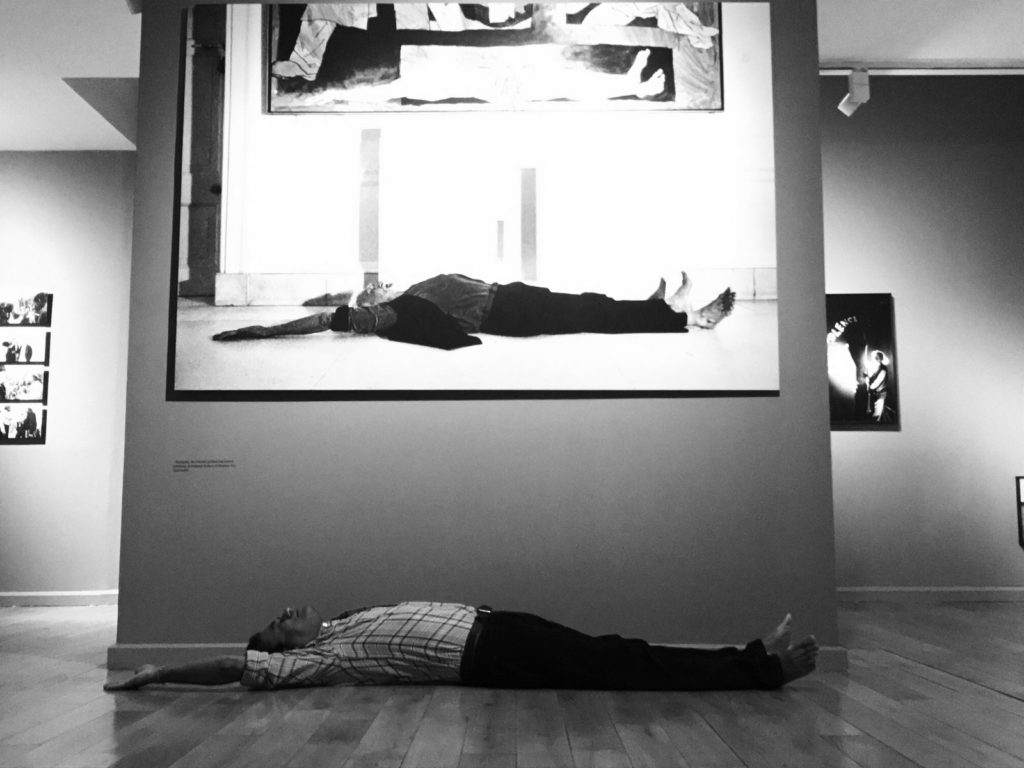
Stretched Terrains
‘Stretched Terrains’ was a set of seven uniquely interrelated-yet independent-exhibitions at the Kiran Nadar Museum in New Delhi. It included solo exhibitions of three modern masters from the Progressive Artists’ Group: MF Husain (‘Yatra: The Rooted Nomad’), SH Raza (The Black Sun), and FN Souza (Man Grinding his Teeth). Also, part of the sequence was a special exhibition on modern architecture of Delhi, a focused perspective on the Vision Exchange Workshop organised by artist Akbar Padamsee in 1968-69, and a photography exhibition of Parthiv Shah (Sadak.Sarai.Sheher.Basti) of his documentation of MF Husain in early 1990s. Responding and parallel to this rich tapestry of different ingenious pursuits, proposals and vocabularies, is the exhibition ‘Interpositions: Replaying the inventory’ showcasing works of four contemporary artists. Parthiv Shah’s exhibition consisted of three distinct body of work, namely, Nizamuddin series, Ramkumar series and NGMA series.
Introduction to Sadak.Sarai.Sheher.Basti: The Recurring Figure
naqsh fariyādī hai kis kī shoḳhi-e-tahrīr kā
kāġhzī hai pairahan har paikar-e-tasvīr kā
-Mirza Ghalib
A distinctly tall figure strolls down the narrow by lanes of the Nizam-ud-din basti, as the towering Urdu poet of the 19th century Ghalib once did, anonymous and familiar at the same time, absorbing the world around and yet looking at it with an ascetic detachment. Ghalib often made poetry as he walked in the inner streets of Delhi where Husain would later spend hours sipping tea at a dhaba or sketching on a newspaper. In the sarai or basti the artist’s attention is everywhere at once, the past with its memories and vanishing worlds, the ever-changing present, and the anticipation of futures to come. Here we are made to meet not the distant and lonely figure of artist-as-genius but, Husain the lifelong lover of spectacles and performance, the bare foot wanderer, the admirer of Ghalib and a devotee of words and lines.
Husain’s inclination for poetry perhaps comes from his adolescent years in Indore where in the Ranipura bazaar, poets would recite their couplets daily. The thrill of such spontaneity, Husain carried with him all his life. The impromptu travel plans, sleeping by the roadside with the same ease as he could meet people in high luxury, the ceaseless hunger for adventure, new friendships forged, but also the time spent with old ones, like long conversations in Humayun’s Tomb with Ram Kumar, all these reveal the persona of Husain, who enjoyed his anonymity as much as his popular stardom.
He is seen drawing and painting on the streets, in the sarai, watched by people passing by or is inspired to perform in front of his own painted figures/characters in the national gallery in the capital city. He loved the cinema from the days he sat on roadside scaffolds painting free-hand cinema hoardings of larger than life portraits of movie stars and living on meager wages in Bombay.
Parthiv Shah’s camera follows Husain as he gets comfortable in the nooks and corners, is quietly presence at the shrine, at the tea stalls, knocks on the door of a stranger’s house, or reads the newspaper, capturing signs of the mundane life around the shrine, while the tomb of his beloved poet lies forsaken.
(Translation of the Urdu couplet : each project in aesthetics-culture-literature, art, every impression, every mark ever made on the surface screams and pleads like an appellant, indicating perhaps how flimsy, papery, ephemeral the outward appearance of everything quaint and picturesque is.)
— (written by) Roobina Karode
View Exhibition
View Media Coverage
Artist In Exile

Parthiv Shah have been photographing M F Husain and his work for many years. He feels that Husain’s art is a part of a longstanding evolving tradition of Indian iconography. Parthiv’s photography creates a dialogue with Husain and his work which extends to the audience. This exhibition in the National Art Gallery, Bangladesh Shilpakala academy
View photographs
View Media Coverage
TheDailyStar.Net article
Husain at 94
For M. F. Husain 94th Birthday, the art fraternity organised an event in his honour. In order to show their support to the great artist, the Safdar Hashmi Memorial Trust (SAHMAT) in association with the Outreach Program of Jamia Millia Islamia, planned a celebration where they exhibited over 100 artworks and screening of Husain’s films like Gaja Gamini, Meenaxi and Through the Eyes of a Painter. This was followed by a book release called Husain at 94 by V.C. Janab Najeeb Jung which was designed by CMAC and a lecture by K. Bikram Singh.
Download Book: Husain at 94
View Media Coverage
About M F Husain
M F Husain (born September 17, 1915, Pandharpur, Maharashtra) is one of India’s best known artists. According to Forbes magazine, he has been called the “Picasso of India”.